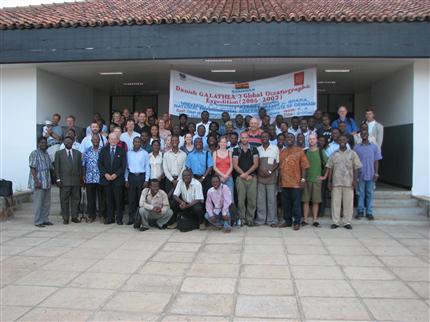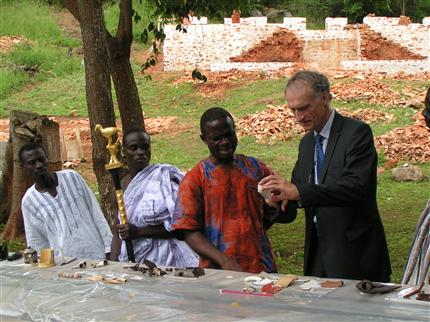A warm welcome in GhanaNewsletter 9
Dato 10.10.2006
Accra - Cape Town
Just after 09.00 hours on the morning of 3 October, VÆDDEREN made land at Tema, 25 km east of the Ghanian capital, Accra.
A warm welcome
The expedition was greeted by Danish and Ghanian flags and an orchestra playing local music.
After the official reception a fair number of local media representatives were there to interview researchers during a press conference. This was followed by an open house and, in the evening, a party for Danish and Ghanian guests.
University of Ghana, Legon
On Wednesday a delegation of expedition members visited the University of Ghana at Legon. First on the agenda was a tour of the Geographical Institute, whose Ecological Laboratory (ECOLAB) Danida (the Danish International Development Agency) helped to set up.
There were talks and entertainment during a lunch of local food. During the afternoon’s scientific seminar, Danish and Ghanian researchers presented their projects to a wider audience.

Photograph Morten Schelde
Danish and Ghanian researchers meet at the University of Ghana, Legon
Modern research operates in an international context. This is evidenced by a number of Galathea 3 researchers, whose work involves collaboration with universities in various countries on the route of the present expedition. The seminar in Accra was a welcome opportunity to strengthen just such a ready-established network – and to form new contacts across both national and subject boundaries.
The former slave coast
History could be revisited at Fort Christiansborg. This fort figures in Thorkild Hansen’s famous trilogy which centres on the Danish/Norwegian slave trade. From around 1600 to 1800, merchant ships loaded with slaves sailed from here to the West Indies. It is thought that 150,000 slaves were sent from Ghana to Danish colonies on the other side of the Atlantic, where they were put to work primarily in sugar plantations.
After the former British colony achieved independence in 1957, Fort Christiansborg became the official residence of the Ghanian president.

Photograph Rane Baadsgaard Lange, The Danish Expedition Foundation
Bertel Haarder, Danish Minister of Education accompanies the project from Accra to Cape Town. Studying archaeological finds from Fredericksgave
We were also afforded a visit to the Danish plantation, Frederiksgave, built in 1832 by King Frederik IV for the Danes on the Gold Coast. Its aim was partly to cultivate crops, partly to provide rest and recuperation from tropical existence and diseases. In contrast to the West Indies, plantations in Ghana were not a success. Frederiksgave was sold to England in 1850 together with other Danish holdings.
An archaeological and rebuilding project is underway, combining the efforts of the National Museum, ECOLAB of the University of Ghana and the Geographical Institute, part of Copenhagen University. Its aim is to reinstate Frederiksgave as a centre of cultural history showing the common inheritance of the two countries. The dig took place in 2005 and work is carried out in close collaboration with the nearby town of Sesemi.
The Equator
On Friday afternoon VÆDDEREN left Tema. Just after midnight on Saturday 7 October the ship crossed the equator. Everyone was called on deck to hear announcements on loudspeakers, to offer cigars to Neptune and be advised of their ‘equatorial baptism’ the following day.
|